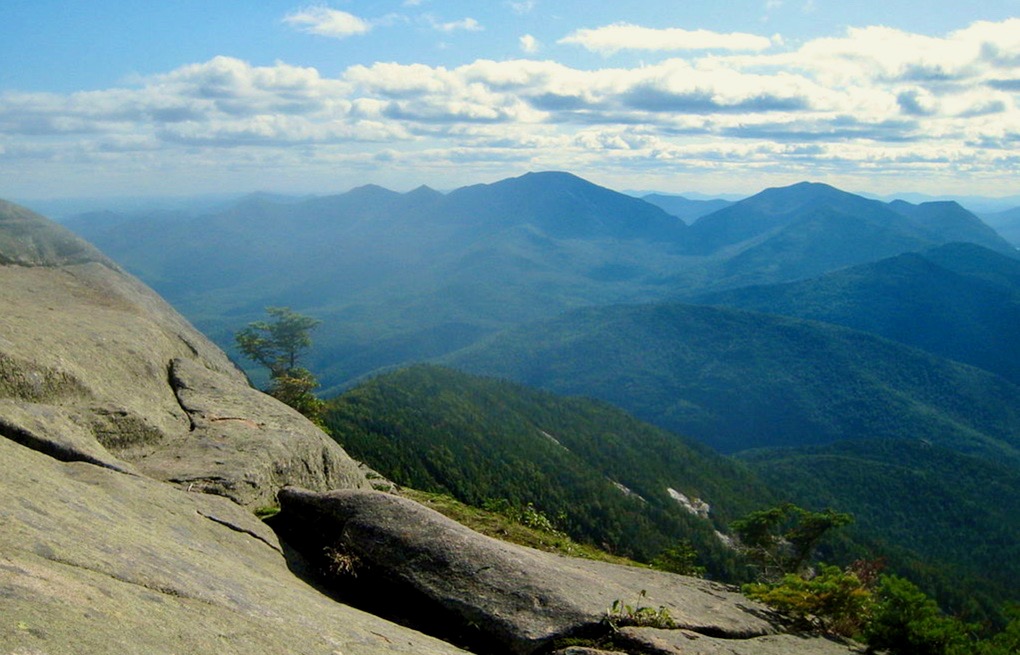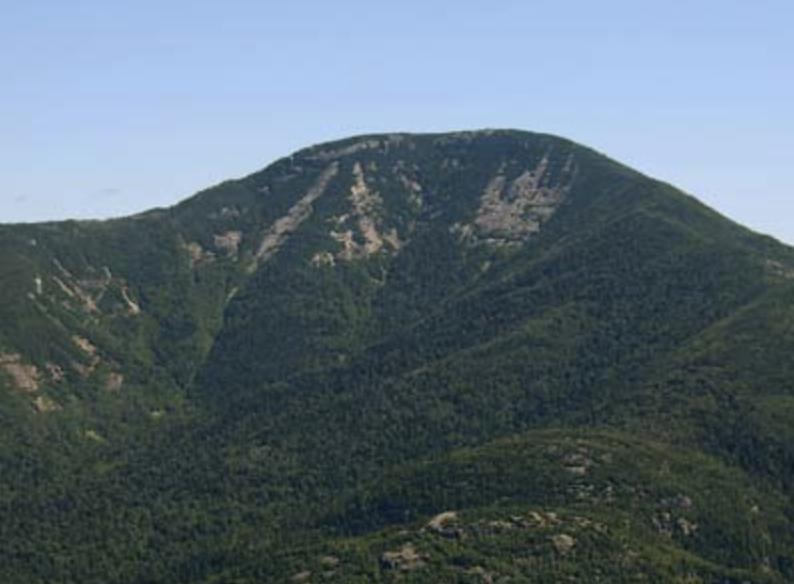Almanac: Rising Giant

View from Giant Mt. in the Adirondacks, a mountain region with a surprising geology. Photo: Creative Commons
It was around 2:30 p.m. last Saturday when a friend and I emerged after a long climb onto the broad open rocks atop Giant Mountain in the Adirondacks. The air was crisp and cold but the sun shone through the clear air and warmed us as we ate lunch. We were overlooking a vast, sheer-sided cirque on the western flank of the mountain, carved by the last wave of glaciers some 12,000 years ago. In the distance stood Mt. Marcy, at 5,343 ft. the highest mountain in New York state. A pair of ravens croaked in the distance, and snippets of French drifted over from several groups of Canadian hikers taking advantage of a holiday there called National Day for Truth and Reconciliation.
My companion idly wondered what type of rock we were sitting on. It was the gray, fine-grained, dense rock common in the Adirondacks, and I had no clue whether it was granite or something else. Hours later, on the drive home, my still-curious friend Googled Adirondack geology. As she read aloud what she found, I had the slightly giddy experience of having everything I thought I knew about the Adirondacks thrown out the window and replaced with facts that I still find surprising.

As is obvious from my inability to identify the rocks at the top of Giant Mt., geology is not my strong suit. But I’ve read about plate tectonics and other basics, so I figured I knew the general story of the Adirondacks: like the rest of the Appalachians, they are the worn-down nubs of an ancient mountain range that, at one time, rivaled the Himalayas in height and scope. The mountains we see as permanent fixtures are actually slowly diminishing, growing flatter over the eons under the inexorable forces of erosion.
Well! I was right about the Appalachians. Dead wrong about the Adirondacks.
First of all, the Adirondacks are not part of the Appalachian mountain chain, which includes the White and Green mountain ranges of New England, the Taconic range in New York, and all the other ranges stretching south to Georgia. The Adirondacks are much, much younger—having formed only about 10 million years ago, as opposed to the estimated 480 million years since the Appalachians formed. And the Adirondacks are not a “range” of mountains like the Appalachians. Instead, they are a roughly circular dome of mountains about 160 miles wide and up to a mile high. The confusing thing is that the rocks of which the Adirondacks are composed are truly ancient—in fact they are estimated to be about a billion years old (and, for the record, they are mostly metamorphic rocks such as granite, gneiss, schist, and marble).
But these “basement” rocks have been uplifted into the Adirondack “dome” by an imperfectly-understood process that continues to this day. Unlike any other mountain area in the eastern part of North America, the Adirondacks are actually getting taller with time at a rate of roughly one foot per century. This is much faster than the rate of erosion, and if you include the subsidence of the lands surrounding the Adirondack dome, the relative rate of growth is even faster than a foot per century.
This has some interesting implications. If the current rate of uplift continues, then roughly 94,500 years from now (the blink of an eye in geologic terms) Mt. Marcy will overtop 6,288-ft. Mt. Washington. It also means that the Adirondacks, which currently sport 46 mountains over 4,000 ft., will increase its collection of 4,000-footers and outnumber the 48 4,000-footers currently in the White Mountains.
It appears that the Adirondacks are being shoved skyward by an immense upwelling of magma squeezed out of the upper portion of the Earth’s mantle. This pool of magma, however, is so deep that it does not result in the kinds of geothermal features such as geysers and hot springs common in other such geologic domes, such as that forming the Yellowstone region. In 2018, geologists using high-resolution acoustic imaging to peer deep into the earth discovered a distinct “anomaly”—a broad area of upwelling magma with a diameter of 70-100 kilometers under the Adirondacks. This was the first confirmation of what had been conjecture ever since the rise in the region’s height was detected in the 1970s.
To the naked eye (and tired foot), the Adirondacks appear no different than their White Mountain cousins and they contain very similar flora and fauna. But it tickles the mind to imagine how radically different these regions are, geologically. Viewed through an extreme time-lapse camera the placid scene from the top of Giant would come alive, the mountains rising, shifting, cracking, and groaning as the eons flicked by. The same view from Mt. Washington would be much quieter, the mountains sinking down slowly, tops rounding off, valleys filling. We are such evanescent creatures that it is only with such flights of fancy that we can begin to grasp the wild dynamism that is the true nature of our fair planet.
Almanac is a regular Indy column of observations, musings, and occasional harangues related to the woods, waters, mountains, and skies of the Pioneer Valley. Please feel free to comment on posts and add your own experiences or observations.

Steve’s Almanac is always thought — and question! — provoking:
Is this Adirondack magma upwelling a multimillion-year effect, or is it more recent (perhaps related to post-glacial isostatic rebound)?
Thick continent-sized ice caps contribute not-insignificantly to the mass balance of a planet like Earth, affecting its shape and thus its dynamics (overall rotation and internal mass flows).
Here’s an interesting thought experiment: we all know that if the Antarctic ice cap melts then global sea levels will rise, but how does that shift the sea surface relative to the Earth’s center of mass, and how will that shift affect relative sea level rise in the northern and southern hemispheres?
Your pieces so often move from particulars that you’ve observed to the unexpected, Steve! Thanks especially for the time-lapse thought-experiment in the last paragraph of this one. I got a kick out of it, and a wondrous sense of expansiveness.
Thanks, Sarah, for commenting on Steve Braun’s wonderful columns! I’ve put off doing so and I always miss him when he’s not in an Indy edition. So however infrequent he might appear it’s always a joy to read his take on all sorts of natural wonders.